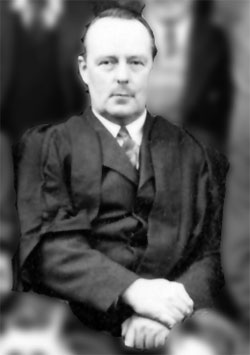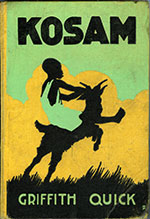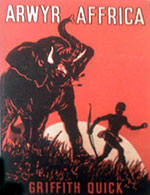Rev. Griffith Quick, M.Sc.
Clergyman and Missionary
(ABGS 1913-1917)

The Rev Griffith Quick
from the 1948 School Photograph
Griffith Quick was a man of strong religious conviction who was brought up in Cwmaman. He spent many years as a missionary in Africa, but from the end of the Second World War he served in Wales as a minister of the Congregational Church.
Griffith Quick was born in Dolgellau, then in Merionethshire, on 28 August 1900. He was the son of William Freeman Quick and his wife Annie, née Owen. His father, William, was from Pwllheli and his mother from Dolgellau, and before moving to Cwmaman to work as a colliery roadman at Fforchaman and Cwmneol collieries, his father worked as a gold miner in the Dolgellau area. Griffith was one of six children, all but two of which were born in Dolgellau. All the children were brought up bilingually. Four of the children survived into adulthood1. The family moved to Cwmaman in about 1904 and lived at 34 Fforchaman Rd, but later moved to 55 Brynmair Road, where Mr & Mrs Quick senior remained into their retirement.
Griffith attended Soar (Calvinistic Methodist) Chapel in Cwmaman and received his initial education at Cwmaman Elementary School and at The Higher Standard Elementary School in the Gadlys. He was admitted into Form 1 of the Boys’ County School in September 1913. He left Form 5 of the main school in July 1917 to become a Student Teacher at Cwmaman Boys’ Elementary School. Academically he was a strong scholar: he took his CWB Junior Certificate in 1916 gaining seven distinctions; his School Certificate in 1917 with one distinction, and within one year his Higher Certificate in 1918 gaining one distinction. His entry into higher education was interrupted when he entered active military service in the Royal Navy on board a mine-sweeper, but in early 1919 he returned home and taught for a brief period at Aman Boys’ School. Then in the autumn of that year he entered the University of College of Wales, Aberystwyth. In 1923, he graduated with an honours degree in Physics, and went on to complete a Board of Education Elementary Teachers’ Certificate, (1924), at the same university. Whilst at Aberystwyth he was active member of the Gymnastics Club, and Rowing Club2.
His first teaching post was at Itchen Secondary School3 in Southampton where he stayed for four terms from September 1924, to the end of the autumn term 1925. Whilst in Southampton he became a member of Above Bar Congregational Church in the centre of the town.

Kosam, about an African
village boy
Griffith then embarked upon a long and significant period in his career when he went to Africa as a missionary. In 1926, he volunteered to work for the London Missionary Society, and left for Northern Rhodesia, (now Zambia). He remained there for 15 years until 1941, during which time he helped establish the Mbereshi Boarding School for Boys, a technical school, a teachers’ training institute and a village school in the Luapula River District.
There were visits home, and in an extended ‘furlough’ in 1932-33, he continued his studies and gained a Teachers’ Diploma, (1933), of the University of London. During this period he also arranged to accompany an HMI on school visits in the UK to improve his knowledge of the education system. Furthermore during this period, he gave a 20-minute talk entitled ‘Byw yn Rhodesia’ on the BBC Home Service (Welsh Region).4
In a second period back in the UK in 1939, he attended courses at the London School of Economics; addressed the Welsh Missionary Service at a gathering in Siloa Vestry, Aberdare; trained at New College, London5; performed various duties for the London Missionary Society throughout the country; and, was ordained as a minister at Above Bar Congregational Church6 in Southampton in the summer of 1939. He then returned to the High School for Boys in Mbereshi; organised a new translation of the Old Testament into Bemba7, and wrote two books of his own, Kosam8: The Story of an African Village Boy, and Arwyr Affrica9. There were also other publications.10

Cover of Arwyr Affrica
In 1941, Griffith Quick left his voluntary work to become chaplain to the King’s African Rifles, (August 1941 to April 1947). He served with them throughout Eastern Africa, producing a handbook in Bemba and Swahili for the use of African soldiers. He returned permanently to Wales in 1947, and quickly completed a dissertation which resulted in the award of an M.Sc. degree (Aberystwyth, 1947) in Social Anthropology. During this period his skills in African languages were recognised by the Colonial Office who asked him to assist with the teaching of Bemba and Swahili to their new recruits at Cambridge University. During this period, Griffith also wrote a Bemba Grammar Book for students of the language.
By the summer of 1948, Griffith was back in Aberdare when he was appointed to the staff of the Aberdare Boys Grammar School to teach Scripture, Geography, Mathematics and Welsh. As the Reverend Quick, he officiated at the ceremony in the old school hall when the WW2 Memorial Plaque was unveiled in 1948, and it was he who dedicated the beech Memorial Lectern and the two memorial bibles, one in English and the other in Welsh. However, after just one term at the school he resigned to become the Minister of the Penybryn English Congregational Church11 in Wrexham where he stayed from January 1949 until 1960. During this period he occupied the chair of the North Wales English Congregational Union, 1958-59.
In the late 1950s Quick was communicating with Cecil B. DeMille about the film The Ten Commandments, and there were plans for the two to meet in the USA. However, DeMille became ill and died, in 1959, before the meeting could take place.
In 1960, Griffith returned to south Wales to fill the post of minister at Rhyddings Congregational Church, Finsbury Terrace, Uplands, Swansea. His residence was at 65, Eaton Crescent.
In 1975, Griffith Quick returned to Mbereshi with the aim of establishing a technical institute. Draft plans were drawn up, but violence and unrest in the region meant that they had to be abandoned.
Griffith Quick died in Swansea in 1980, aged 79. There is no record of a marriage.
Footnotes
- William Roderick Quick (1899-1975), George Frederick Quick (1904-1916), Nancy Quick
(1905-1992) (Nancy Brock after marriage), Meirion Trevor Quick (1907- 1989), Dilys Elizabeth
Quick (1916-2003). There was also another child who died in infancy.
Meirion T. Quick emigrated to Australia where he became a farmer. He married Estelle Weston and raised five children in New South Wales. He died in Narrabri District Hospital on 20th December 1989, and lies buried in Narrabri Lawn Cemetery.
Griffith’s sister Dilys Elizabeth Quick, (1916-2003), also taught at Aberdare Boys’ County School, (Geology & Geography 1940-42). On vacating this post, she went west, taking up a teaching position at Gowerton Secondary School for Girls, but ended her career teaching at the Swansea Training College. Like her brother, she too added to her initial academic qualifications during her career; initially B.A. (UCW 1938), she later acquired both an M.A. and a Ph.D. In the late 80s and early 90s Dilys Quick served on the committee of Capel, (Cymdeithas Treftadaeth Y Capeli — The Chapels Heritage Society). Dilys was born in Aberdare, and attended the Aberdare Girls’ County School, 1928-35. In Swansea she lived at Belgrave Court, Uplands. Her funeral service took place at Llwydcoed Crematorium Aberdare, on 22nd December 2003. - The Aberystwyth University Archive at the Hugh Owen Library, Penglais, holds photographs of the college sports clubs including ones in which Griffith Quick is depicted performing gymnastics, 1922-23, (Reference GB GB0982 UWA-PHO-D-(viii)-11), also present in this photograph is an Aberdare County School contemporary of Quick, namely Cecil Raymond Escott who was Champion, 1922-1923, and Club President, (C.R. Escott was the elder brother of another former pupil, Percy Escott, who concluded his teaching career at Caradog Primary School in Aberdare. C. R. Escott made a career in the Royal Navy where he attained the rank of Lieutenant-Commander. He settled in the Weymouth area); the library also holds a photograph of the rowing club dated 1921-22 which also includes Griffith Quick, (Reference GB GB0982 UWA-PHO-D-(vii)-3).
- Now Itchen Sixth Form College, Middle Road, Bitterne, Southampton.
- BBC Home Service (Welsh Region), Sunday, September 4th 1938.
- New College London was founded as a Congregationalist college in 1850. Although it no longer exists, the work of the college has been continued since 1981 by the New College London Foundation which trains ministers for the URC and Congregational churches.
- The Above Bar Congregational Church in Southampton was destroyed by wartime bombing on 30 November 1940.
- Bemba is the most spoken indigenous language in Zambia.
- Quick, G., Kosam, The London Missionary Society, First Edition edition (1937).
- Quick, G., Arwyr Affrica, Llyfrau'r Dryw; First edition (1958).
- Heckel, B. & Quick. G., The Yao Tribe. Their Culture and Education.
Arts and Crafts in the Training of Bemba Youth, Oxford University Press London.
(1935);
Quick, G., Arts and Crafts in the Training of Bemba Youth, (1935).
Quick, G., Penybryn Congregational church, Wrexham: anniversary handbook, 175 years, 1783-1958, (Birmingham, 1958), 12pp. - The Penybryn English Congregational Church in Wrexham is now known as Salisbury Park United Reformed Church. It is situated in Percy Road.